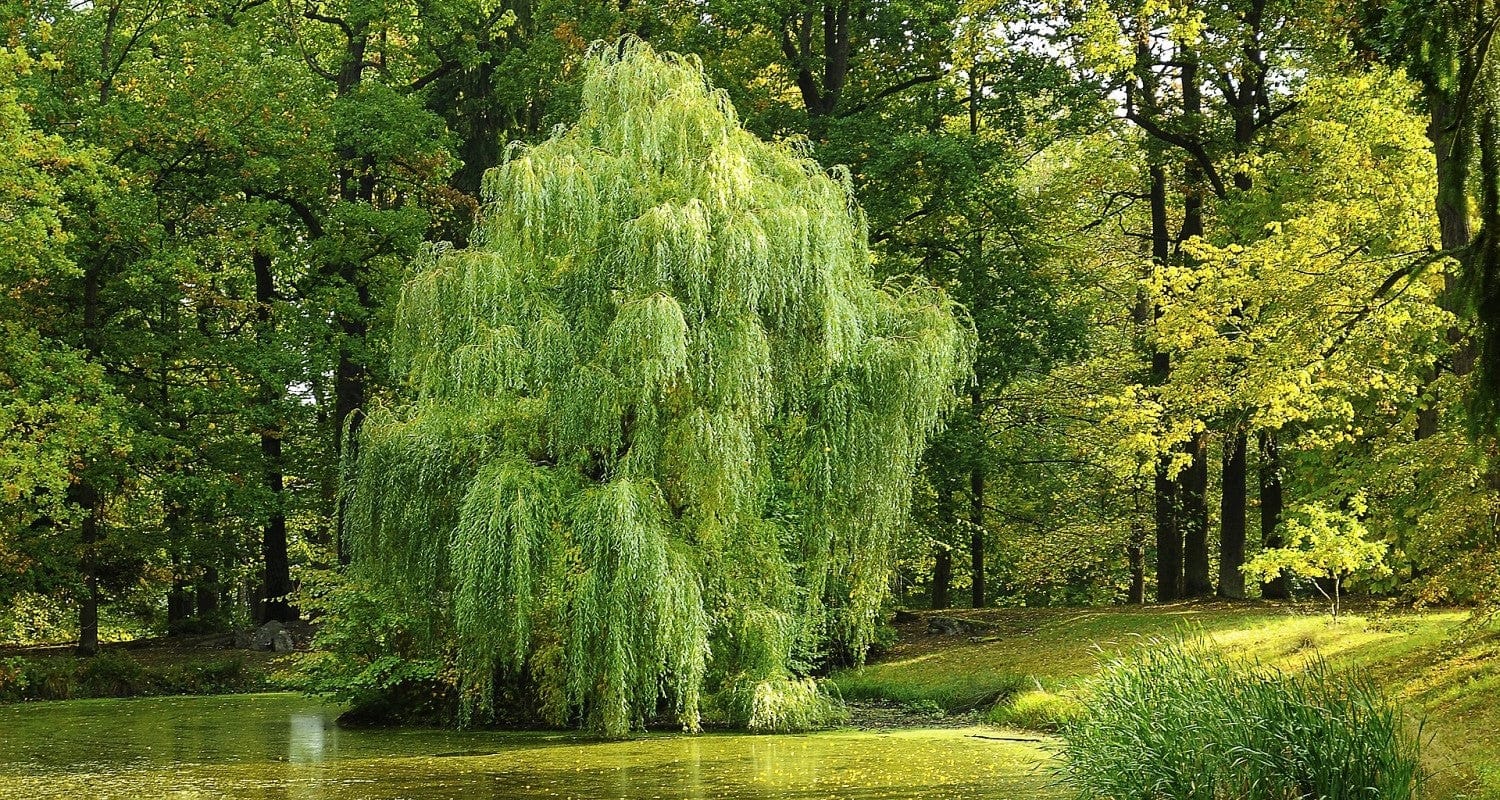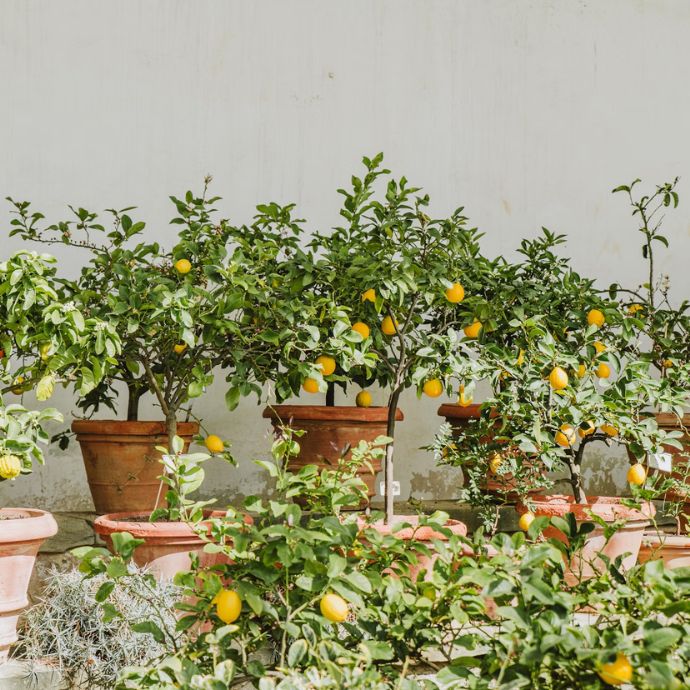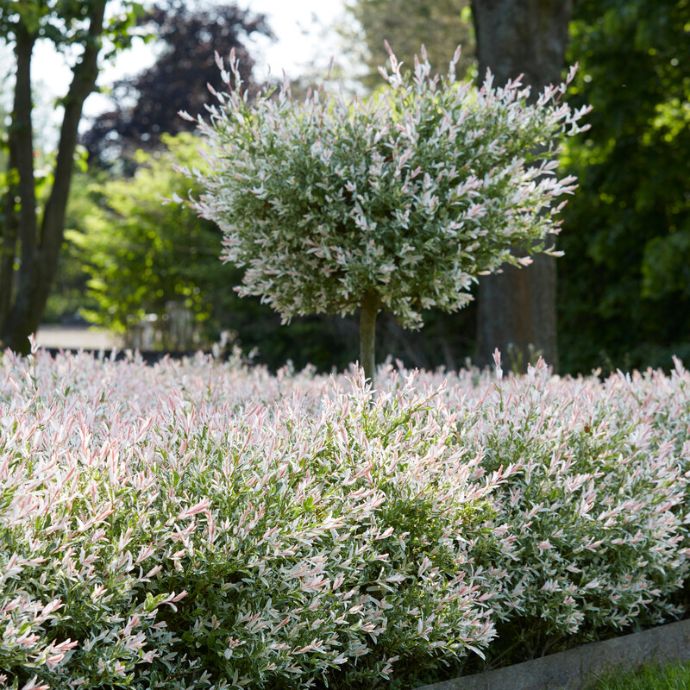Advice & Inspiration
Is My Garden Suitable for a Willow Tree?

Willow trees (Salix) are some of the most popular ornamental trees in the UK, with types of Willow trees including Weeping, Corkscrew, Flamingo Willows and more. They’re some of the earliest plants to come back to life in spring, with pollen-rich catkins emerging in April to attract the bees. Given their good looks, low maintenance needs and variety of sizes and forms, a Willow tree is a great choice for any garden. We asked our growers which Willow they’d recommend for each situation, the optimum conditions for a Willow tree, and how to care for them.
Jump to:
- Best specimen tree
- Best for small gardens
- Best for pots
- Best for hedging
- Best for winter interest
- Best for wildlife
- What do Willow trees need?
- Care guide
Which Willow tree is the best for your garden?
These are the varieties recommended by our growers.
Best for a specimen tree: Golden Weeping Willow (Salix chrysocoma)
Weeping willow trees are a classic feature of the English landscape, often found lining riverbanks or next to ponds, with their sweeping yellow stems reflected in the water. The best place for a Weeping Willow tree is on wet ground, but they also make a wonderful feature in a large lawn, providing a cool, shaded spot to relax on a summer afternoon. In spring the branches will be covered in sunny yellow catkins before the green summer foliage emerges; the tree then lives up to its name again when the leaves turn golden yellow in autumn.
Best for small gardens: Flamingo Willow (Salix integra ‘Hakuro Nishiki’)
This adorable small Willow tree is best shown off in a front garden or a mixed border, where its changing colours can be fully appreciated. The display starts off in spring with yellow catkins that turn pink as they mature. They’re followed by flamingo pink foliage which turns to a mixture of pink, green, white and variegated leaves and in autumn it's the turn of the reddish stems to take the spotlight. Often pruned into a standard or ‘lollipop’, the Flamingo Willow grows to just 2 x 1.5m and can even be grown in a pot.
Best for pots: Kilmarnock Dwarf Weeping Willow (Salix caprea)
Another great choice for small gardens is the Kilmarnock Weeping Willow, which will grow to a compact 2 x 1.5m. It’s our choice for pots as the slightly elevated position of the potted tree shows off the gracefully weeping form to its best advantage. This is the classic ‘pussy’ or ‘goat’ willow, with dark brown arching stems covered in fluffy grey catkins which open to soft yellow and white flowers in spring which appear before the bright green foliage. We especially love this willow in winter when its dark wood and weeping form look beautiful when covered in frost or snow!
Best for hedging: Scarlet Willow (Salix alba ‘Chermesina’)
Scarlet Willow is a striking tree in its own right, but we think it makes a spectacularly vibrant hedge that’s a godsend for areas with wet soil in which other hedging plants would struggle. The bright orange-red stems contrast vividly with grey-green foliage that turns warm yellow in autumn and the fluffy, pollen-rich catkins ensure that this hedge will be buzzing with beneficial insects in the spring. The red stems remain through the winter, adding an extra season of interest.
Best for winter interest: Corkscrew Willow (Salix matsudana ‘Tortuosa’)
The twisted, spiralling stems of the Corkscrew Willow make a real splash in the winter landscape, but this isn’t just a one-season wonder. The branches are smooth and copper coloured and when the tree is in leaf, the bright green foliage creates a delightful upswept canopy enhanced by small yellow catkins in spring. Corkscrew Willow can grow to 15m tall, but responds very well to pruning, making it suitable for any size of garden.
Best for wildlife: Goat Willow (Salix caprea)
Grown in Britain since Roman times, the Goat Willow attracts a wide variety of native wildlife including many species of butterflies and moths including the Regal Purple Emperor. The catkins are silver grey with yellow tips and make a colourful contrast with the red-brown stems and bright green foliage. It also works brilliantly as a hedge. The name Goat Willow comes from an illustration in a 1546 herbal which showed a goat feeding on the tree but although it’s highly attractive to wildlife, there is no evidence that goats like this tree more than any other!
What do Willow trees need?
Not much is the short answer! Most Willow trees grow best in boggy, wet or damp conditions - that’s why you’ll often see these iconic trees lining riverbanks and in wetlands and explains why they’ve been growing happily in the UK climate since the end of the last Ice Age. They’re usually disease proof and after the first few years, need little if any pruning.
How to care for your Willow tree
1. Position
Willow trees do best in a sunny spot with cool, deep, moist soil but will be fine with a little dappled shade - 4-6 hours of direct sunlight daily is ideal. They do have quite sprawling root systems, so avoid planting them right next to your house or any boundary fences.
2. Watering
You should water your young Willow tree regularly for the first year after planting, but after that its root system will be well established and you won’t need to worry about watering except in extended hot and dry spells.
3. Feeding
Although Willows do just fine without fertiliser, you can enhance their display or catkins by applying an annual feed of general purpose slow-release feed right at the start of spring. If your soil is a bit on the poor side, it’s also a good idea to mix in some compost at the planting stage.
4. Pruning
Young Willow trees should be pruned to encourage a good shape with vibrant new stems. Here’s how:
Year 1
Choose the strongest upright stem as the leader and prune back the others. This will become the trunk of the tree.
Years 2 and 3
Prune branches that are not growing upwards at the correct angle and those which are too horizontal, then remove any weak or unhealthy branches that are crowding out the stronger ones. As the tree grows, prune off any shoots that develop too low down the trunk, to stop them growing into straggly branches too near the ground.
This work will pay off once the tree is established, when all you’ll have to do each year is remove any dead, damaged or crossing branches if necessary.

























